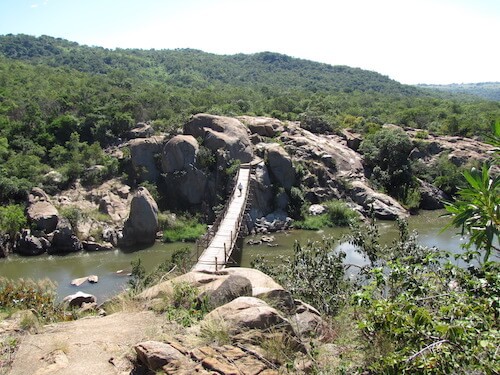 “Leave me here, I can’t go any further,” I wailed dramatically as I slumped against a rock.
“Leave me here, I can’t go any further,” I wailed dramatically as I slumped against a rock.
The sun was relentless, and I’d abandoned my water bottle long ago to keep both hands free for better balancing on the rocks. Now our enthusiastic guide Lucky Mavuso was leading us over more enormous boulders i wasn’t not brave enough to tackle.
What was supposed to be a modest stroll to see ancient potholes carved by the Komati River in Eswatini had turned into quite an adventure. We were aiming for The Gap, where the river disappears under a strange landscape of perfectly round holes hollowed out in rocks by centuries of swirling waters. I squeezed into a shady crevice while the others grabbed a fat hosepipe incongruously laid across the rocks, and used it to abseil down to the potholes.
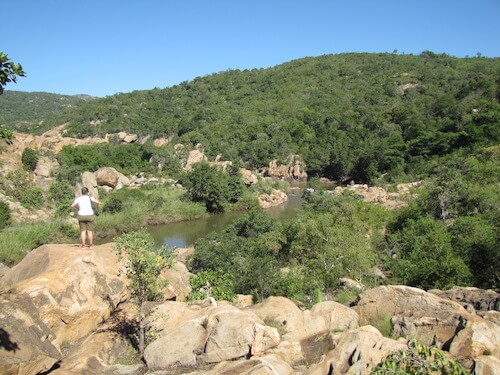 Talking of pot, we discovered why there’s a hosepipe when we hiked back to the road. A field of bright green Swazi Gold marijuana was growing happily, irrigated directly from the river. Lucky advised us that someone seriously scary would be keeping a close eye on us and his illicit crop, so we hastily walked on.
Talking of pot, we discovered why there’s a hosepipe when we hiked back to the road. A field of bright green Swazi Gold marijuana was growing happily, irrigated directly from the river. Lucky advised us that someone seriously scary would be keeping a close eye on us and his illicit crop, so we hastily walked on.
Earlier we’d hiked an easier trail to the nearby Nsangwini Rock Art cave, the largest example of San art in the country. Visitors are led there by members of the community, and Namcile Dlamini pointed out paintings of men and animals dating back from 400 to 4000 years ago.
Eswatini might sound like a rural backwater, but there’s a surprising amount going on in this tiny kingdom. It’s only about five hours from Joburg to the border at Ngwenya, and most activities are handily positioned in this north-west corner. All the road signs are in English, making it easy to get around. Prices are also attractive for cash-strapped South Africans, with the Rand accepted alongside the Lilangeni and worth the same.
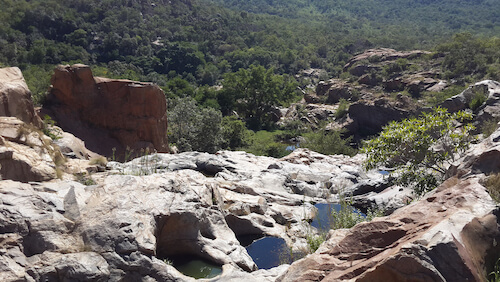 Soon after crossing the border you can pull into Ngwenya Glass Factory, which supports the community by creating jobs and buying the used glass they collect. Even on a hot day the temperature outside is nothing compared to the heat indoors, as you stand on a balcony watching workers insert long poles into the kilns. They draw out orange balls of molten glass and roll it like giant candy floss. I watched one man roll the glowing globule against his thickly-gloved hand and couldn’t help wincing at the mere thought of an accident. A man directly below me glanced up, then waved and held up his latest creation – a cute, fat orange rhino!
Soon after crossing the border you can pull into Ngwenya Glass Factory, which supports the community by creating jobs and buying the used glass they collect. Even on a hot day the temperature outside is nothing compared to the heat indoors, as you stand on a balcony watching workers insert long poles into the kilns. They draw out orange balls of molten glass and roll it like giant candy floss. I watched one man roll the glowing globule against his thickly-gloved hand and couldn’t help wincing at the mere thought of an accident. A man directly below me glanced up, then waved and held up his latest creation – a cute, fat orange rhino!
After admiring the shop filled with elephant-handled wine glasses and unbelievably heavy bookends I enjoyed a spinach and feta pancake and coffee milkshake in the café upstairs. Several small shops scattered across the lawn stock crafts made by local women’s groups, and I greeted the owners in my basic Zulu, which is acceptably similar to siSwati.
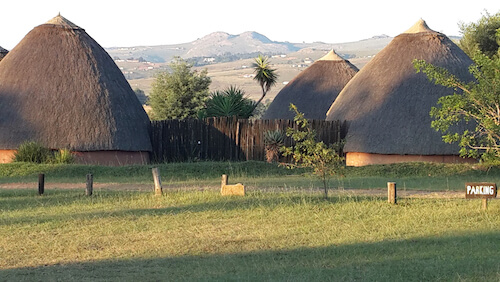 That night we slept at Hawane Resort, in comfortable thatched huts with sinks and baths moulded out of concrete, in a style that’s functionally rustic. When my companions went horse riding the next morning I lay reading by the pool, stymied by an allergy to horses. But I was back in action for zip lining at Malolotja Canopy Tour, where 10 ziplines span gorges in a nature reserve. The views are brilliant, once you settle into the swing and look around rather than focusing on the solid rock face you’re whizzing towards. There’s a narrow suspension bridge to tackle too, high above the Majolomba River, which proved far more disconcerting than speeding down a steel wire.
That night we slept at Hawane Resort, in comfortable thatched huts with sinks and baths moulded out of concrete, in a style that’s functionally rustic. When my companions went horse riding the next morning I lay reading by the pool, stymied by an allergy to horses. But I was back in action for zip lining at Malolotja Canopy Tour, where 10 ziplines span gorges in a nature reserve. The views are brilliant, once you settle into the swing and look around rather than focusing on the solid rock face you’re whizzing towards. There’s a narrow suspension bridge to tackle too, high above the Majolomba River, which proved far more disconcerting than speeding down a steel wire.
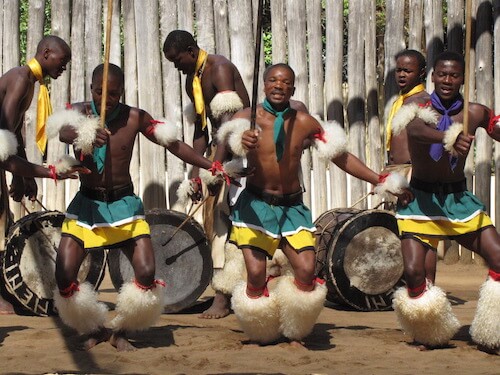 Another excellent attraction is Mantenga Cultural Village, with traditional thatched homes, a nice restaurant and the option of staying overnight in modern accommodation. We were shown around by Mbuluzi Malindzisa, who calls himself Paul for anyone who can’t be bothered with his real name. We arrived just in time for one of the twice daily dance displays, where enthusiastic boys show off their movements, hunky muscular men show how it’s done properly, unmarried maidens demonstrate a desirable flexibility, and married women lead the musical accompaniment. It’s a great show, with the pounding drums and frenzied dancing of the sangoma stirring your soul.
Another excellent attraction is Mantenga Cultural Village, with traditional thatched homes, a nice restaurant and the option of staying overnight in modern accommodation. We were shown around by Mbuluzi Malindzisa, who calls himself Paul for anyone who can’t be bothered with his real name. We arrived just in time for one of the twice daily dance displays, where enthusiastic boys show off their movements, hunky muscular men show how it’s done properly, unmarried maidens demonstrate a desirable flexibility, and married women lead the musical accompaniment. It’s a great show, with the pounding drums and frenzied dancing of the sangoma stirring your soul.
Then Mbuluzi showed us the village, with a dry sense of humour bubbling up as he explains the living arrangements. In one cooking area he tells us that women aren’t allowed to cook all the parts of an animal in case they get funny ideas. “If she cooks the brain she’ll become too intelligent, if she cooks the feet she’ll run away, and if she cooks the tongue she’ll talks too much,” he jokes.
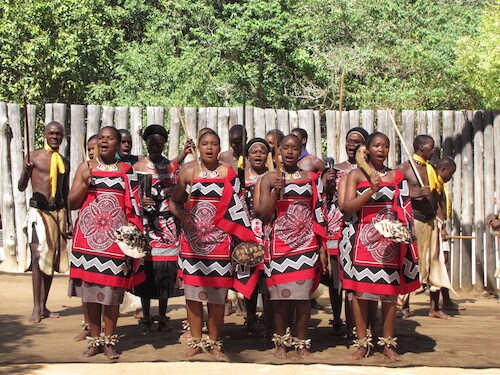 As we drove through gorgeous scenery of rolling hills, rondevals and misty peaks marching into the distance, our guide Lucky told wonderful stories of the culture. He explained the tribal habits and gave us tidbits of gossip about King Mswati III.Before my visit all I knew about Eswatini was the Reed Dance, which seems to involve an over-married monarch selecting yet another young and nubile bride each year.
As we drove through gorgeous scenery of rolling hills, rondevals and misty peaks marching into the distance, our guide Lucky told wonderful stories of the culture. He explained the tribal habits and gave us tidbits of gossip about King Mswati III.Before my visit all I knew about Eswatini was the Reed Dance, which seems to involve an over-married monarch selecting yet another young and nubile bride each year.
Mavuso pointed out the home of one of the queens, who live all over the country. Then we passed a soldier guarding King Swati’s palace. I couldn’t see much for the trees, but it didn’t look particularly large or ostentatious. No, Lucky agreed, “It’s not like Nkandla.”
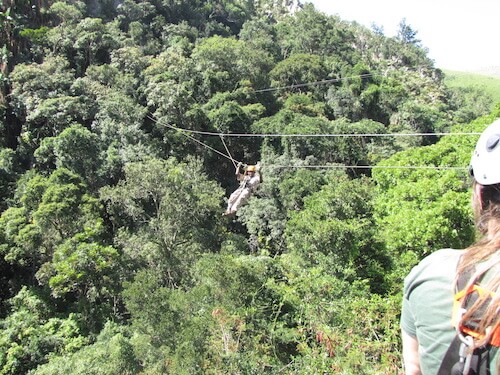 Top Tips:
Top Tips:
In a country as culturally rich as Eswatini, it’s fun to stay in traditional accommodation. The thatched beehive huts at Mlilwane Wildlife Sanctuary are fabulous, with 14 clustered in each of a four separate kraals, so it can cope if there’s suddenly a high demand for sleeping in a hut. My heart sank when I first saw my room, until I stooped down and opened the solid wooden door. What a relief – inside it’s delightful, with a gorgeous thatched roof, two proper beds and my own bathroom cleverly attached in a concrete annex. This is going rural for wimps, with the Hippo Haunt restaurant serving wine and a buffet before the staff break into a bout of tribal dancing.
During the day you can hike, hire a bike, take a game drive or go horse riding. I took a guided bike tour, pedalling past unperturbed antelope and zebra, and stopping to admire a large croc, thankfully on the other side of the river. The camp sits by a forest, a hippo pool and grassy plains, with Nyonyane Mountain as a dramatic backdrop, just 45 minutes from Ngwenya border post. Tel: +268 2528 3943/4 Email: reservations@biggameparks.org
For more hot stuff visit Ngwenya Glass Factory. Tel: +268 24424053
Tour guide Nhlanhla Lucky Mavuso will drive you around or put together a complete agenda for you: lucnhla@yahoo.co.uk. Tel: +268-7603-1260.
Nsangwini Rock Art Caves are open daily 8am to 4pm. Tel: +68-7668-1732.
Malolotja Nature Reserve for zip lining. Tel: +268 2444 3048
Hawane Resort: or Tel (+268) 2444 1744
Mantenga Cultural Village – open from 8am - 5pm with dance displays at 11:15am and 3.30pm.
For more ideas, see www.thekingdomofeswatini.com
To enter eSwatini now you need to show a negative Covid test no more than 72 hours old. You’ll also need another negative test result to re-enter South Africa, again not older than 72 hours. With Covid regulations changing regularly, see these pages for the latest advice:
https://www.thekingdomofeswatini.com/travel-advice/#coronavirus and on Facebook: https://www.facebook.com/groups/eswatinitravel